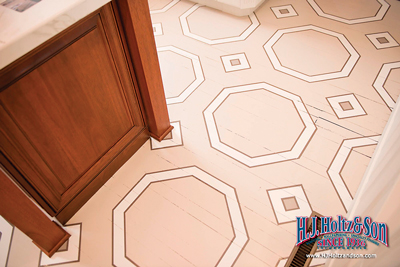Homeowners today want to stand out from their neighbors. Of course, designers are fans of using unique colors and textures on the walls, but creativity doesn’t need to stop there. Both the floors and the ceilings are fair game to help accomplish that wow factor.
In the design and contracting business, we often refer to the ceiling as the fifth wall. As such, it’s just as important as any other wall in the room. Decorating your ceiling can help elevate a simple room to a masterful level. Here are a few techniques to consider.
Colored Paint
Frankly, some wall color options don’t look great with bright, white ceilings. An accent-colored ceiling can highlight moldings and accentuate the other details of the room. Many homeowners choose a high-gloss finish to give the ceiling depth and to reflect the other colors in the room. Alternatively, adding minimal contrast between the walls and ceiling can make a small room feel larger. It encourages your eyes to travel upward creating a flow to the room.
Mural or Stencil
Adding a mural or stencil will add interest to your room. You can use any pattern and color you want. These techniques can be used across
the whole ceiling, around the perimeter, or just surrounding a light fixture.
Wallpaper
Believe it or not, wallpapering your ceiling is an option (should we call that ceiling-papering?). It adds texture and visual interest to the room. Plus, depending on your walls, it can help achieve balance between the ceiling and the walls.
Beadboard
Install beadboard on your ceiling to add character and architecture to your room. If you can incorporate stain into your design, you will add warmth to your room as well as make a large room feel more cozy and inviting.
A decorative floor can provide one of the most powerful and innovative makeovers for a home or business, creating a visual centerpiece that will also hide flaws or imperfections. It easily adapts to any design, from traditional to contemporary. A decorative floor is well-suited to a large area, but a smaller area can be made to appear larger by using a large, open pattern. As with the ceiling, the possibilities are limited only by your imagination. Here are the primary techniques to consider.
Painting or Staining
Picking out a paint or stain color to make a statement or complement the rest of the decor may be all the space needs. Durable paint coatings aren’t just for garage floors. Painted concrete has made its way indoors and can be kept simple, or made to look like expensive tile. Existing hardwoods can be stained a new color to give them a whole new life.
Decorative Pattern
In addition to a uniform color, you may want to consider a decorative pattern. A pattern adds a layer of interest and diffuses wear in any size room. It is a great way to update or mask dirt and damage caused by children and pets over the years.
Getting the patterned floor you want requires a multi-step process. After a design has been created, a flooring specialist sands and removes all stain and polyurethane from the existing floor. Once the raw floor has been exposed, skilled craftsmen lay out the pattern. Subsequently, one must layer the stains or paint (or both), then tape, and reverse-tape multiple times, depending on the number of colors and the complexity of the design. Upon completion of this process, a protective coating must be applied to the floor in a gloss or matte finish.
A decorative floor is a unique and dramatic addition to any home or space. The possibilities of painted and stained decorative floor designs are truly endless.






